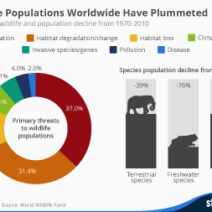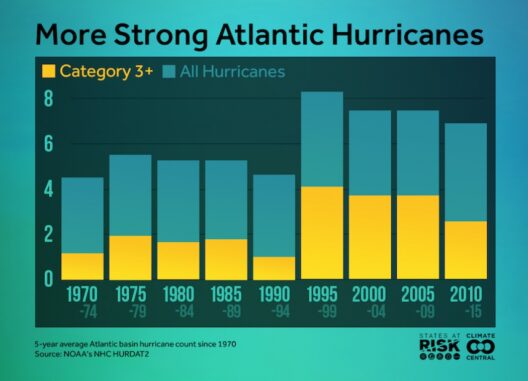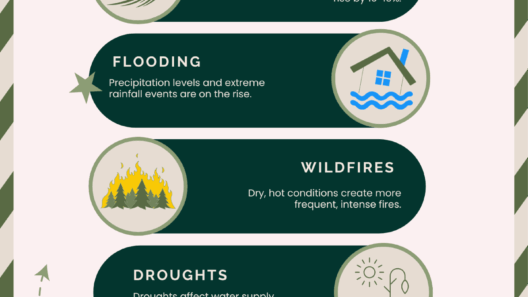How do oceans, the majestic blue expanses that dominate our planet, contribute to the complex interplay of global warming? This question not only sparks curiosity but also highlights a critical challenge in understanding Earth’s climate system. Oceans are much more than mere bodies of water; they serve as significant regulators of global climate patterns and play a monumental role in the ongoing battle against climate change.
The properties of oceanic water—its temperature, salinity, and circulation patterns—are crucial in determining how the oceans interact with the atmosphere. Ocean temperatures have risen steadily due to the accumulation of greenhouse gases in the atmosphere, which subsequently leads to the absorption of heat by the ocean. This increase in temperature results in several notable phenomena, such as sea-level rise and altered weather patterns.
In terms of heat absorption, oceans have an unparalleled capacity. They absorb approximately 90% of the excess heat generated by global warming, acting as a buffer against immediate atmospheric temperature increases. However, this sequestration of heat has its repercussions. As ocean temperatures rise, thermal expansion occurs, contributing significantly to rising sea levels. Moreover, warmer waters can disrupt marine ecosystems, affecting everything from coral reefs to fish migration patterns.
Furthermore, the salinity of ocean water is a vital factor in regulating climate. Variations in salinity are influenced by freshwater inflow from rivers, ice melt, and precipitation, which in turn affect ocean circulation patterns. The thermohaline circulation, commonly known as the “global conveyor belt,” is driven by differences in water density, which is determined by temperature and salinity. Disruptions to this circulation can have widespread implications, including shifts in regional climates and altered weather patterns across the globe.
Moreover, oceans are integral to the carbon cycle. They absorb a significant amount of carbon dioxide (CO2) from the atmosphere, which is utilized by marine organisms for photosynthesis. However, this process leads to ocean acidification—a phenomenon where increased CO2 levels cause a decrease in pH levels of ocean waters. Ocean acidification adversely affects marine life, particularly organisms with calcium carbonate shells, such as corals and shellfish. A challenge lies in the dual role oceans play: while they mitigate climate change by sequestering CO2, the resulting acidification poses a threat to marine biodiversity and the fisheries that many human communities rely upon.
Another critical aspect of how oceans affect climate change is their influence on weather patterns through evaporation and precipitation processes. The oceans are a vast source of moisture, and when they evaporate, the resulting water vapor becomes a greenhouse gas. This process contributes to the atmospheric greenhouse effect, helping to trap heat and maintain Earth’s temperature. However, increased evaporation also leads to climate extremes, including heavier rainfall events and prolonged droughts, creating a paradox: while oceans play a role in regulating climate, they also contribute to its unpredictability.
The interplay between ocean currents and global climate is intricate and multifaceted. The Gulf Stream is a prominent example of an ocean current that affects temperature and weather across the North Atlantic region. Changes in this current due to global warming could lead to significant cooling in some areas while causing warming in others. This duality highlights the complex responses of oceans to changing climate conditions and raises questions about the future resilience of these systems under anthropogenic pressures.
Oceans also act as vital biodiversity reservoirs, housing about 230,000 known species, with millions more possibly undiscovered. Healthy marine ecosystems not only provide habitat for a myriad of life forms but also help in stabilizing the climate. Mangroves, seagrasses, and coral reefs play critical roles in carbon sequestration, protecting coastlines, and nurturing juvenile marine life. However, the recent onslaught of climate change threatens these ecosystems. Coral bleaching events, driven by elevated sea temperatures, have led to the mass loss of coral colonies, jeopardizing the biodiversity that depends upon them.
Yet, we stand at a tipping point. The challenge of addressing climate change through improved ocean management is becoming increasingly urgent. The implementation of marine protected areas, sustainable fisheries management, and restoration of coastal habitats are essential strategies that can enhance ocean resilience. Engaging local communities in conservation efforts is equally critical; they can become stewards of their marine environments, ensuring that these ecosystems thrive even in the face of climate change.
So, how can we harness the potential of the oceans as climate regulators? This question beckons collaboration across sectors and nations, integrating scientific research with policy initiatives. Innovations in technology, such as satellite monitoring and oceanic modeling, provide invaluable insights into the dynamics of marine systems. By investing in carbon capture and storage techniques, countries can utilize oceanic properties to mitigate greenhouse gas emissions effectively.
Ultimately, the oceans are not just passive recipients of climate change; they actively shape and influence global climate systems. The intricate web of interactions among ocean properties—temperature, salinity, circulation, and ecosystems—creates a delicate balance, which, if disrupted, can lead to catastrophic outcomes. Our understanding—the challenge we face in preserving the oceans—offers a unique opportunity to combat climate change proactively. Protecting our oceans equates to safeguarding the future of our planet.
In conclusion, the oceans are both a pivotal ally and a formidable adversary in the fight against climate change. Understanding how ocean properties affect global warming requires a multifaceted approach that embraces education, research, and active engagement. By overcoming the challenge of climate change through directed and informed actions, we can ensure that the oceans continue to serve as Earth’s climate regulators for generations to come.








